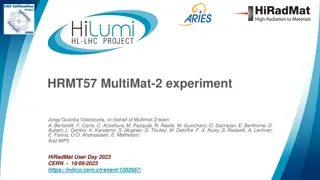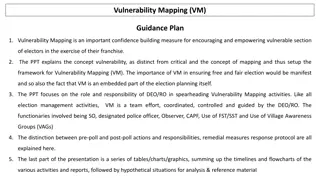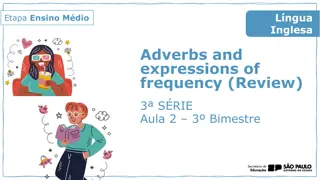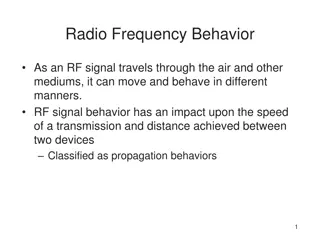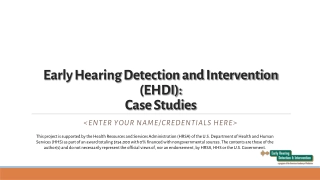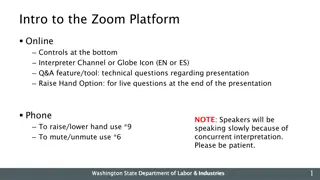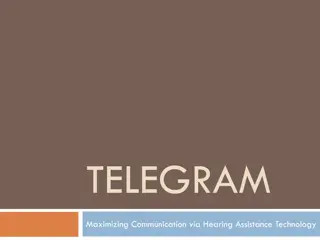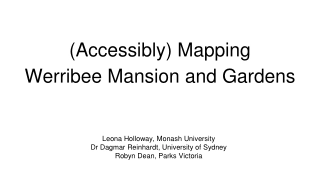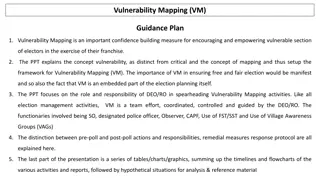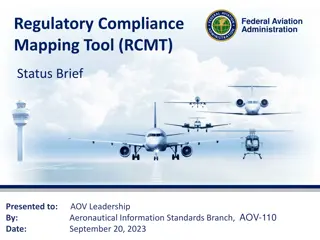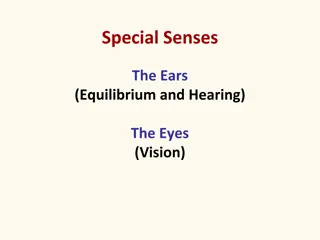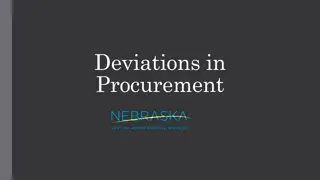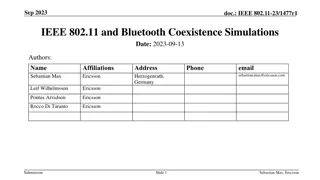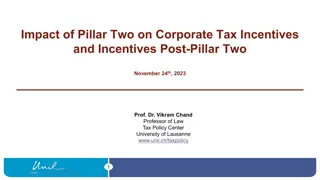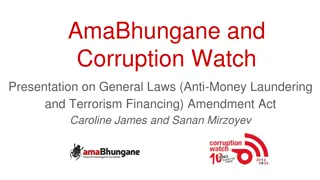Understanding Audiometric Worksheets: Frequency Mapping for Hearing Thresholds
Explore how audiometric worksheets represent hearing thresholds across frequencies, including patient details, equipment used, test results, and more. Learn about different audiogram forms, symbols used, and how to assess hearing loss type, degree, and laterality. Gain insights into interpreting audiometric graphs and understanding the implications for hearing health.
Download Presentation
Please find below an Image/Link to download the presentation.
The content on the website is provided AS IS for your information and personal use only. It may not be sold, licensed, or shared on other websites without obtaining consent from the author. Download presentation by click this link. If you encounter any issues during the download, it is possible that the publisher has removed the file from their server.
Presentation Transcript
It a graph that represents the hearing thresholds across frequencies . The audiometric worksheet might represent all or some of the following information; Patient s name. The audiometric worksheet might represent all or some of the following information; Patient s name. Patient s age (date of birth). Patient s age (date of birth). Patient s gender. Patient s gender.
Referral source. MR No. MR No. Equipment used (its name and model number) Test results reliability ( good, fair, poor). Examiner name and signature. Examiner name and signature.
Day and date of the examination. Day and date of the examination. PTA calculation Speech tests results Imittance tests results (Tymp, Reflexes) Box to write any additional comments
The horizontal axis represents the Frequency in hertz ( Hz) and the vertical axis represents the intensity in dB HL. There are 2 audiogram forms forms: 1. One-graph audiogram 2. Two-graphs audiogram
1. Audiogram with one graph for both right and left ear results
2. Audiogram with 2 graphs, each graph represents the results of each ear, one graph for RE and one graph for LE.
The used symbols connected by solid line results solid BC line for AC results results and no connection between NR AC results , dotted line dotted line for BC
First, Is there a hearing loss or not?, Compare the collected results with the normal hearing results Second, If there is a hearing loss; what is the type of it?. Compare the AC and BC results
Third, What is its degree?, Calculating the PTA or looking for whole frequencies thresholds Forth, Is it bilateral ( both ears involved) or unilateral ( just one ear affected). Fifth, In Bilateral cases; Symmetrical (both side identical) Asymmetrical ( both side non-identical) In Bilateral cases; is it
Sixth, What is the hearing loss configuration? , Shape of audiogram
Normal hearing Normal AC thresholds obtained across all tested frequencies. (< 20 dB) Normal BC thresholds obtained across all frequencies tested. (<20 dB) There is no significant difference between both AC and BC thresholds ( Air-bone gape < 10 dB).
Abnormal AC threshold (> 20 dB HL) obtained across the tested frequencies. Normal BC thresholds ( < 20 dB HL) obtained across the tested frequencies. Air- bone gap present ( > 10 dB).
AC thresholds are abnormal ( > 20 dB HL) across tested frequencies. BC thresholds are abnormal (> 20 dB HL ) across tested frequencies. A.B gap absent ( 10 dB)
Bilateral SNHL Vs Unilateral SNHL
AC thresholds were abnormal (> 20 dB HL) across tested frequencies . BC thresholds were abnormal ( > 20 dB HL ) across tested frequencies. A.B gap is present ( > 10 dB)
Pure Tone Average to summaries the degree of hearing loss. Pure Tone Average (PTA) is usually used It s useful for predicting the threshold for speech It gives a gross impression of the degree of communication problems resulted from hearing loss
Traditionally, Its the mean of the AC thresholds at 500, 1000 and 2000 Hz because it often agrees with hearing ability for speech.. PTA = 500 Hz (T)+ 1000 Hz (T) + 2000 Hz (T) / 3 PTA = 500 Hz (T)+ 1000 Hz (T) + 2000 Hz (T) / 3
Variable pure tone average (VPTA), pure tone average of the poorest three threshold of (500, 1000, 2000 and 4000), ( Clark. 1981) May be it s more reflective for degree of communication impact of hearing loss than the traditional method Variable pure tone average (VPTA), is the The PTA is usually compared with what s known as Speech Recognition ( reception) threshold (SRT) and any significant difference (> 5-8dB) between PTA and SRT considered of clinical significant.
The 2 frequency pure tone average lowest 2 thresholds at 500, 1000 and 2000 Hz), better 2, may be recorded and it s been stated to be more predictor of hearing for speech than the traditional way 2 frequency pure tone average (the It is used instead of the 3 frequencies PTA for comparison, whenever the audiogram shape does not allow the straight comparison and agreement between PTA and SRT.
Sometimes one frequency used ( 250 or 500 Hz). one frequency comparison When the PTA does not reflect the actual Hearing loss patient has, the degree could be describes based on the audiogram shape
Bilateral: When the hearing loss affects both ears, it s a bilateral hearing loss.
Unilateral: When one ear is with normal hearing and the other ear is showing hearing loss, it s a Unilateral Hearing loss.
Asymmetrical When the hearing loss is bilateral but one ear shows greater loss than the other ( hearing loss degree differs), it s asymmetrical hearing loss.
Symmetrical When the hearing loss is bilateral and the degree and configuration of the hearing loss is identical for both ears, it s symmetrical hearing loss
Audiogram Configuration is the criteria that summaries the audiogram slop and shape; Flat (difference between the thresholds just from 5-10 dB) Audiogram Configuration is the criteria that summaries the audiogram slop and shape; Steeply slopping (sharp slop). Gradually slopping.
Rising. HF hearing loss. LF hearing loss. Audiogram with dip/ notch. Cookie byte. (Saucer shape) Reversed Cookie byte.
Audiogram with a notch at high frequencies. Like 3000-6000 Hz notch, indicates Noise Induced hearing loss.
Audiogram with a notch at 2000 Hz (Carhart notch), AC meets BC threshold at that frequency, indication of otoscelrosis.
In a summary, include; In a summary, to diagnose you have to Bi/ unilateral/ degree of hearing loss/ audiogram configuration whenever possible/ type of hearing loss. Example; bilateral symmetrical high frequency moderately- severe SNHL.
If its Unilateral hearing loss which ear; (Unilateral (RE) mild CHL) Unilateral hearing loss, states If it s bilateral asymmetrical hearing loss start to describe the less effected side first. bilateral asymmetrical hearing loss, Do not forget to indicate to fluctuating audiogram.
1 1- - False responses False responses; The responses that may mislead the examiner and give false results. They are either false positive or false negative.
when the patient respond without stimulus presentation. It usually happened with a) Children as they are highly motivated to respond b) Patients with tinnitus if the stimulus resembling their tinnitus frequency.
These could be overcome by either o Slow down the test and watch carefully Reinstruct the patient. o Present another tone type to help the patient differentiate the stimulus from their tinnitus like (FM tone) o
When the patient does not response in the presence of the stimulus. May happen as result of poor attention, patient needs to be reinstructed. It may reflects unreliable responses in patients who are faking their hearing loss for any reason (pesudohypercusis).
2- Standing wave; It is usually seen at 6000-8000 Hz threshold. It happened as the distance between the eardrum and the headphone diaphragm can be very close to the 8000 Hz wavelength, so the tone and it s reflection will be about 180 degree out of phase and they will cancel each other and no tone heard.
The threshold at this frequency may be come higher than the real one. It is mostly happened if 8000 Hz threshold better than 4000 Hz one. Using the insert earphone helpful in that case.
3- Tactile response; Vibrotactile sensation of low frequency BC signals. 4- Acoustical radiation; ; Sound escapes from the BV at 3000- 4000 Hz and improve the BC threshold.
5- Collapsed ear canal; Collapsing of the cartilaginous part of the ear canal during the AC testing. Which obstruct the sound flow. It results in high frequency CHL with A.B gab range from 10-50 dB and poor test- retest reliability. Extra care considered when high frequency A.B gap detected.






